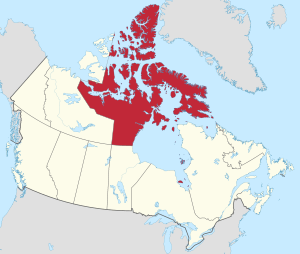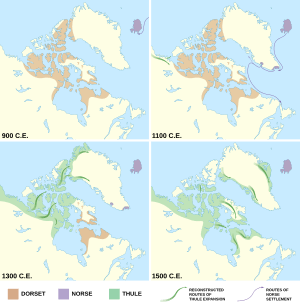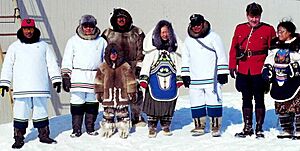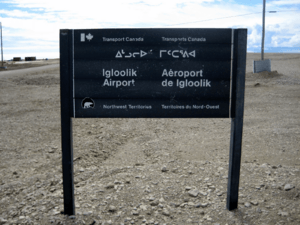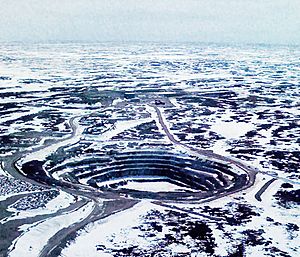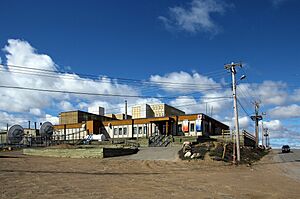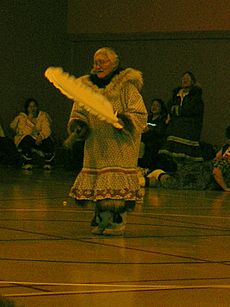Nunavut facts for kids
Quick facts for kids
Nunavut
Inuktitut syllabics ᓄᓇᕗᑦ
|
|||
|---|---|---|---|
|
|||
| Motto(s):
ᓄᓇᕗᑦ ᓴᙱᓂᕗᑦ (Nunavut Sannginivut)
"Our land, our strength" "Notre terre, notre force" |
|||
| Country | Canada | ||
| Confederation | April 1, 1999 (13th) | ||
| Capital | Iqaluit | ||
| Largest city | Iqaluit | ||
| Government | |||
| • Type | Parliamentary system, with consensus government | ||
| Area
(2021 – land, 2020 – water)
|
|||
| • Total | 1,997,923.78 km2 (771,402.68 sq mi) | ||
| • Land | 1,836,993.78 km2 (709,267.26 sq mi) | ||
| • Water | 160,930 km2 (62,140 sq mi) 8.1% | ||
| Area rank | Ranked 1st | ||
| 20% of Canada | |||
| Population
(2021)
|
|||
| • Total | 36,858 | ||
| • Estimate
(Q2 2024)
|
40,758 | ||
| • Rank | Ranked 13th | ||
| • Density | 0.02/km2 (0.05/sq mi) | ||
| Demonym(s) | Nunavummiut Nunavummiuq (sing.) |
||
| Official languages | Inuit (Inuktitut and Inuinnaqtun) English French |
||
| GDP | |||
| • Rank | 12th | ||
| • Total (2017) | C$2.846 billion | ||
| • Per capita | C$58,452 (6th) | ||
| HDI | |||
| • HDI (2021) | 0.930 – Very high (4th) | ||
| Time zones | UTC−07:00 (MST) | ||
| • Summer (DST) | UTC−06:00 (MDT) | ||
| UTC−06:00 (CST) | |||
| • Summer (DST) | UTC−05:00 (CDT) | ||
| Southampton Island (Coral Harbour) | UTC−05:00 (EST) | ||
| UTC−04:00 (Eastern Time) | |||
| • Summer (DST) | UTC−04:00 (EDT) | ||
| Postal abbr. |
NU
|
||
| Postal code prefix |
X0A, X0B, X0C
|
||
| ISO 3166 code | CA-NU | ||
| Flower | Purple saxifrage | ||
| Tree | n/a | ||
| Bird | Rock ptarmigan | ||
| Rankings include all provinces and territories | |||
Nunavut (/ˈnʊnəvʊt/, /ˈnuːnəvuːt/; French: [nunavut], [nunavʊt], [nynavʏt]; Inuktitut: ᓄᓇᕗᑦ, [nunaˈvut], lit. our land) is the largest and northernmost territory of Canada. It was separated officially from the Northwest Territories on April 1, 1999, via the Nunavut Act and the Nunavut Land Claims Agreement Act, which provided this territory to the Inuit for self-government. The boundaries had been drawn in 1993. The creation of Nunavut resulted in the first major change to Canada's political map in half a century since the province of Newfoundland (now Newfoundland and Labrador) was admitted in 1949.
Nunavut comprises a major portion of Northern Canada and most of the Arctic Archipelago. Its vast territory makes it the fifth-largest country subdivision in the world, as well as North America's second-largest (after Greenland). The capital Iqaluit (formerly Frobisher Bay), on Baffin Island in the east, was chosen by a capital plebiscite in 1995. Other major communities include the regional centres of Rankin Inlet and Cambridge Bay.
Nunavut includes Ellesmere Island in the far north, the eastern and southern portions of Victoria Island in the west, and all islands in Hudson, James and Ungava bays, including the western portion of Killiniq Island in the southeast and Akimiski Island far to the south of the rest of the territory. It is Canada's only geopolitical region that is not connected to the rest of North America via the Pan-American Highway.
Nunavut is the least densely populated major country sub-division in the world (not considering Antarctica), being even less densely populated than Denmark's Greenland. With a population of 36,858 as of the 2021 Canadian census (up from 35,944 in 2016) consisting mostly of Inuit, and a land mass almost as large as Mexico, Nunavut's land area of 1,836,993.78 km2 (709,267.26 sq mi) has a population density of 0.022/km2 (0.057/sq mi).
Nunavut is also home to the world's northernmost continuously inhabited place, Alert. Eureka, a weather station on Ellesmere Island, has the lowest average annual temperature of any Canadian weather station.
Contents
History
Early history
The region which is now mainland Nunavut was first populated approximately 4,500 years ago by the Pre-Dorset, a diverse Paleo-Eskimo culture that migrated eastward from the Bering Strait region.
The Pre-Dorset culture was succeeded by the Dorset culture about 2,800 years ago. Anthropologists and historians believe that the Dorset culture developed from the Pre-Dorset somehow.
Helluland, which Norse explorers described visiting in their Sagas of Icelanders, has been associated with Nunavut's Baffin Island. Claims of contact between the Dorset and Norse are controversial.
The Thule people, ancestors of the modern Inuit, began migrating from Alaska in the 11th century into the Northwest Territories and Nunavut. By 1300, the geographic extent of Thule settlement included most of modern Nunavut.
The migration of the Thule people coincides with the decline of the Dorset. Thule people genetically and culturally completely replaced Dorset some time after 1300.
European exploration
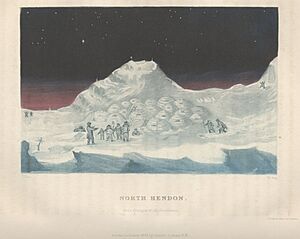
The earliest written historical account of the area is dated to 1576, an account by English explorer Martin Frobisher. While leading an expedition to find the Northwest Passage, Frobisher thought he had discovered gold ore around the body of water now known as Frobisher Bay on the coast of Baffin Island. The ore turned out to be worthless, but Frobisher made the first recorded European contact with the Inuit. Other explorers in search of the elusive Northwest Passage followed in the 17th century, including Henry Hudson, William Baffin and Robert Bylot.
20th and 21st centuries
Cornwallis and Ellesmere Islands featured in the history of the Cold War in the 1950s. Concerned about the area's strategic geopolitical position, the federal government, as part of the High Arctic relocation, relocated Inuit from Nunavik (northern Quebec) to Resolute and Grise Fiord. In the unfamiliar and hostile conditions, they faced starvation but were forced to stay.
Forty years later, the Royal Commission on Aboriginal Peoples issued a report titled The High Arctic Relocation: A Report on the 1953–55 Relocation. The government paid compensation to those affected and their descendants. On August 18, 2010, in Inukjuak, the Honourable John Duncan, PC, MP, previous Minister of Indian Affairs and Northern Development and Federal Interlocutor for Métis and Non-Status Indians formally apologized on behalf of the Government of Canada for the relocation of Inuit to the High Arctic.
Discussions on dividing the Northwest Territories along ethnic lines began in the 1950s, and legislation to achieve this was introduced in 1963. After its failure, a federal commission recommended against such a measure.
During the 1970s, activism increased among the Inuit, First Nations, and Innu peoples for recognition of their forced assimilation. In 1976, as part of the land claims negotiations between the Inuit Tapiriit Kanatami (then called the "Inuit Tapirisat of Canada") and the federal government, the parties discussed division of the Northwest Territories to provide a separate territory for the Inuit. On April 14, 1982, a plebiscite on division was held throughout the Northwest Territories. A majority of the residents voted in favour and the federal government gave a conditional agreement seven months later.
The land claims agreement was completed in September 1992 and ratified by nearly 85% of the voters in Nunavut in a referendum. On July 9, 1993, the Nunavut Land Claims Agreement Act and the Nunavut Act were passed by the Canadian Parliament. The transition to establish Nunavut Territory was completed on April 1, 1999.
In 2020, Nunavut imposed strict travel regulations in order to prevent an outbreak of the COVID-19 pandemic. The government barred entry to almost all non-residents. As of October 2020, it was the only place in North America to have had no cases of COVID-19. On November 6, 2020, Nunavut confirmed its first case in Sanikiluaq.
Geography
Nunavut covers 1,836,993.78 km2 (709,267.26 sq mi) of land and 160,930 km2 (62,137 sq mi) of water in Northern Canada. The territory includes part of the mainland, most of the Arctic Archipelago, and all of the islands in Hudson Bay, James Bay, and Ungava Bay, including the Belcher Islands, all of which were part of the Northwest Territories from which Nunavut was separated. This makes it the fifth-largest subnational entity (or administrative division) in the world. If Nunavut were a country, it would rank 15th in area.
Nunavut has long land borders with the Northwest Territories on the mainland and a few Arctic islands, and with Manitoba to the south of the Nunavut mainland; it also meets Saskatchewan to the southwest at a quadripoint, and has a short land border with Newfoundland and Labrador on Killiniq Island. The boundary with the Northwest Territories roughly approximates the tree line in Canada. Nunavut shares maritime borders with the provinces of Quebec, Ontario, and Manitoba. With Greenland, a constituent country of the Danish Realm, it shares a primarily maritime international border that includes a short land border on Hans Island.
Nunavut's highest point is Barbeau Peak (2,616 m (8,583 ft)) on Ellesmere Island. The population density is 0.022/km2 (0.057/sq mi), one of the lowest in the world. By comparison, Greenland has approximately the same area and nearly twice the population.
Climate
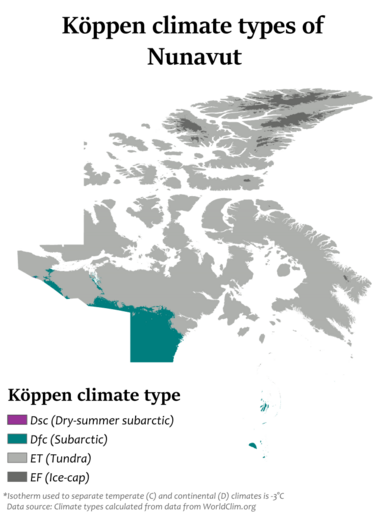
Nunavut experiences a polar climate in most regions, owing to its high latitude and lower continental summertime influence than areas to the west. In more southerly continental areas, very cold subarctic climates can be found, due to July being slightly milder than the required 10 °C (50 °F).
| City | July (°C) | July (°F) | January (°C) | January (°F) | ||||
|---|---|---|---|---|---|---|---|---|
| High | Low | High | Low | High | Low | High | Low | |
| Alert | 6 | 1 | 43 | 33 | −29 | −36 | −20 | −33 |
| Baker Lake | 17 | 6 | 63 | 43 | −28 | −35 | −18 | −31 |
| Cambridge Bay | 13 | 5 | 55 | 41 | −29 | −35 | −19 | −32 |
| Eureka | 9 | 3 | 49 | 37 | −33 | −40 | −27 | −40 |
| Iqaluit | 12 | 4 | 54 | 39 | −23 | −31 | −9 | −24 |
| Kugluktuk | 16 | 6 | 60 | 43 | −23 | −31 | −10 | −25 |
| Rankin Inlet | 15 | 6 | 59 | 43 | −27 | −34 | −17 | −30 |
| Climate data for Iqaluit (Iqaluit Airport) WMO ID: 71909; coordinates 63°45′N 68°33′W / 63.750°N 68.550°W; elevation: 33.5 m (110 ft); 1991–2020 normals, extremes 1946–present |
|||||||||||||
|---|---|---|---|---|---|---|---|---|---|---|---|---|---|
| Month | Jan | Feb | Mar | Apr | May | Jun | Jul | Aug | Sep | Oct | Nov | Dec | Year |
| Record high humidex | 3.3 | 5.2 | 4.3 | 6.8 | 13.3 | 21.7 | 27.8 | 27.6 | 18.8 | 8.6 | 4.8 | 3.4 | 27.8 |
| Record high °C (°F) | 3.9 (39.0) |
5.7 (42.3) |
4.2 (39.6) |
7.2 (45.0) |
13.3 (55.9) |
22.7 (72.9) |
26.8 (80.2) |
25.5 (77.9) |
18.4 (65.1) |
9.1 (48.4) |
5.6 (42.1) |
3.8 (38.8) |
26.8 (80.2) |
| Mean daily maximum °C (°F) | −22.0 (−7.6) |
−22.9 (−9.2) |
−17.6 (0.3) |
−8.9 (16.0) |
−0.3 (31.5) |
7.0 (44.6) |
12.0 (53.6) |
11.1 (52.0) |
5.6 (42.1) |
−0.5 (31.1) |
−7.5 (18.5) |
−14.7 (5.5) |
−4.9 (23.2) |
| Daily mean °C (°F) | −26.0 (−14.8) |
−27.0 (−16.6) |
−22.4 (−8.3) |
−13.5 (7.7) |
−3.2 (26.2) |
3.9 (39.0) |
8.1 (46.6) |
7.5 (45.5) |
2.9 (37.2) |
−3.2 (26.2) |
−11.1 (12.0) |
−18.9 (−2.0) |
−8.6 (16.5) |
| Mean daily minimum °C (°F) | −29.9 (−21.8) |
−31.0 (−23.8) |
−27.2 (−17.0) |
−18.1 (−0.6) |
−6.1 (21.0) |
0.7 (33.3) |
4.2 (39.6) |
3.8 (38.8) |
0.2 (32.4) |
−5.8 (21.6) |
−14.7 (5.5) |
−23.0 (−9.4) |
−12.2 (10.0) |
| Record low °C (°F) | −45.0 (−49.0) |
−45.6 (−50.1) |
−44.7 (−48.5) |
−34.2 (−29.6) |
−26.1 (−15.0) |
−10.2 (13.6) |
−2.8 (27.0) |
−2.5 (27.5) |
−12.8 (9.0) |
−27.1 (−16.8) |
−36.2 (−33.2) |
−43.4 (−46.1) |
−45.6 (−50.1) |
| Record low wind chill | −65.4 | −65.6 | −62.1 | −53.1 | −36.0 | −18.8 | −7.2 | −8.6 | −18.6 | −42.9 | −56.8 | −60.1 | −65.6 |
| Average precipitation mm (inches) | 16.3 (0.64) |
14.0 (0.55) |
21.4 (0.84) |
22.7 (0.89) |
21.0 (0.83) |
48.7 (1.92) |
39.8 (1.57) |
61.7 (2.43) |
50.8 (2.00) |
30.2 (1.19) |
18.5 (0.73) |
16.2 (0.64) |
361.2 (14.22) |
| Average rainfall mm (inches) | 0.4 (0.02) |
0.1 (0.00) |
0.0 (0.0) |
0.0 (0.0) |
3.3 (0.13) |
46.1 (1.81) |
44.4 (1.75) |
65.5 (2.58) |
43.9 (1.73) |
12.3 (0.48) |
0.7 (0.03) |
0.0 (0.0) |
216.6 (8.53) |
| Average snowfall cm (inches) | 19.4 (7.6) |
15.1 (5.9) |
20.6 (8.1) |
23.8 (9.4) |
23.0 (9.1) |
3.8 (1.5) |
0.0 (0.0) |
0.1 (0.0) |
8.5 (3.3) |
21.1 (8.3) |
25.9 (10.2) |
28.8 (11.3) |
190.0 (74.8) |
| Average precipitation days (≥ 0.2 mm) | 12.1 | 10.7 | 12.4 | 12.8 | 10.6 | 12.3 | 12.4 | 14.3 | 15.7 | 13.2 | 12.5 | 12.8 | 151.5 |
| Average rainy days (≥ 0.2 mm) | 0.06 | 0.06 | 0.06 | 0.06 | 1.7 | 10.7 | 13.1 | 14.8 | 13.2 | 3.8 | 0.24 | 0.0 | 57.7 |
| Average snowy days (≥ 0.2 cm) | 10.1 | 8.8 | 8.7 | 9.6 | 8.7 | 2.1 | 0.06 | 0.12 | 3.7 | 9.8 | 11.9 | 12.7 | 86.3 |
| Average relative humidity (%) (at 3pm) | 68.1 | 67.6 | 68.9 | 74.6 | 77.3 | 74.6 | 72.9 | 73.5 | 75.2 | 78.7 | 78.4 | 74.3 | 73.7 |
| Mean monthly sunshine hours | 32.4 | 94.0 | 172.2 | 216.5 | 180.5 | 200.2 | 236.8 | 156.8 | 87.9 | 51.4 | 35.6 | 12.6 | 1,476.8 |
| Percent possible sunshine | 18.5 | 39.0 | 47.4 | 48.2 | 31.9 | 32.5 | 39.3 | 31.0 | 22.4 | 16.8 | 17.7 | 8.9 | 29.5 |
| Average ultraviolet index | 0 | 0 | 1 | 2 | 4 | 4 | 4 | 3 | 2 | 1 | 0 | 0 | 2 |
| Source 1: Environment and Climate Change Canada (Bright Sunshine 1981–2010) | |||||||||||||
| Source 2: Weather Atlas | |||||||||||||
Demography
Visible minority and indigenous identity (2016): Inuit (84.7%) European Canadian (11.6%) Visible minority (2.5%) First Nations (0.5%) Métis (0.5%) Other Indigenous responses (0.2%)
Nunavut has a population of 36,858 from the 2021 Census. In 2021, 30,865 people identified as Inuit (84.3% of the total population), 180 as First Nations (0.5%), 120 as Métis (0.3%), 230 with multiple or other Indigenous responses (0.6%), and 5,210 as non-Indigenous (14.2%).
| Municipality | 2021 | 2016 | 2011 |
Change 2011–2021 |
Refs. |
|---|---|---|---|---|---|
| Iqaluit | 7,429 | 7,740 | 6,699 | 10.9% | |
| Rankin Inlet | 2,975 | 2,842 | 2,557 | 16.2% | |
| Arviat | 2,864 | 2,657 | 2,060 | 39.0% | |
| Baker Lake | 2,061 | 2,069 | 1,728 | 19.3% | |
| Igloolik | 2,049 | 1,744 | 1,538 | 33.2% | |
| Cambridge Bay | 1,760 | 1,766 | 1,452 | 21.2% | |
| Pond Inlet | 1,555 | 1,617 | 1,315 | 18.3% | |
| Pangnirtung | 1,504 | 1,481 | 1,325 | 13.5% | |
| Kinngait | 1,396 | 1,441 | 1,363 | 2.4% | |
| Kugluktuk | 1,382 | 1,491 | 1,302 | 6.1% |
The population growth rate of Nunavut has been well above the Canadian average for several decades, mostly due to birth rates significantly higher than the Canadian average—a trend that continues. Between 2011 and 2016, Nunavut had the highest population growth rate of any Canadian province or territory, at a rate of 12.7%. The second-highest was Alberta, with a growth rate of 11.6%. Between 2016 and 2021, the population growth increased by 2.5% (the third lowest), a decrease of 10.2 percentiles from the previous census.
Nunavut has the highest smoking rate in all of Canada, with more than half of its adult population smoking cigarettes. Both men and women smoke regularly. Some 90% of pregnant women are smokers, although studies have shown it has detrimental effects.
Language
Official languages are the Inuit language (Inuktitut and Inuinnaqtun), known as Inuktut, English, and French.
In his 2000 commissioned report (Aajiiqatigiingniq Language of Instruction Research Paper) to the Nunavut Department of Education, Ian Martin of York University said that a "long-term threat to Inuit languages from English is found everywhere, and current school language policies and practices on language are contributing to that threat" if Nunavut schools follow the Northwest Territories model. He provided a 20-year language plan to create a "fully functional bilingual society, in Inuktitut and English" by 2020.
The plan provided different models, including:
- "Qulliq Model", for most Nunavut communities, with Inuktitut to be the main language of instruction.
- "Inuinnaqtun Immersion Model", for language reclamation and immersion to revitalize Inuinnaqtun as a living language.
- "Mixed Population Model", mainly for Iqaluit (possibly for Rankin Inlet), where the population is 40% Qallunaat, or non-Inuit, and may have different requirements.
Of the 34,960 responses to the census question concerning "mother tongue" in the 2016 census, the most commonly reported languages in Nunavut were:
| Rank | Language | Number of respondents | Percentage |
|---|---|---|---|
| 1 | Inuktitut | 22,070 | 63.1% |
| 2 | English | 11,020 | 31.5% |
| 3 | French | 595 | 1.7% |
| 4 | Inuinnaqtun | 495 | 1.4% |
At the time of the census, only English and French were counted as official languages. Figures shown are for single-language responses and the percentage of total single-language responses.
In the 2016 census it was reported that 2,045 people (5.8%) living in Nunavut had no knowledge of either official language of Canada (English or French). The 2016 census also reported that of the 30,135 Inuit in Nunavut, 90.7% could speak either Inuktitut or Inuinnaqtun.
Religion
In 2021 census, Christianity constitutes 73.5% of Nunavut's population down from 86% in the 2011 Census. The percentage of population which is non-religious has grown from 13% in 2011 to 24.9% in 2021 Census. About 1.6% of the population reported another religious affiliation including Aboriginal spirituality, Hinduism, Islam, Buddhism, and others.
Economy
The economy of Nunavut is driven by the Inuit and Territorial Government, mining, oil, gas, and mineral exploration, arts, crafts, hunting, fishing, whaling, tourism, transportation, housing development, military, research, and education. Currently, one college operates in Nunavut, the Nunavut Arctic College, as well as several Arctic research stations located within the territory. The new Canadian High Arctic Research Station CHARS is planning for Cambridge Bay and high north Alert Bay Station.
Iqaluit hosts the annual Nunavut Mining Symposium every April, a tradeshow that showcases the many economic activities ongoing in Nunavut.
Baffinland is the territory's largest private sector employer with more than 2,600 workers and accounted for 23 per cent of Nunavut's economic activity in 2019.
Mining
There are currently three major mines in operation in Nunavut. Agnico-Eagle Mines Ltd – Meadowbank Division. Meadowbank Gold Mine is an open pit gold mine with an estimated mine life 2010–2020 and employs 680 people.
The second mine in production is the Mary River Iron Ore mine operated by Baffinland Iron Mines. It is located close to Pond Inlet on North Baffin Island. They produce a high grade direct ship iron ore.
The most recent mine to open is Doris North or the Hope Bay Mine operated near Hope Bay Aerodrome by TMAC Resource Ltd. This new high grade gold mine is the first in a series of potential mines in gold occurrences all along the Hope Bay greenstone belt.
Mining projects
| Name | Company | In the region of | Material |
|---|---|---|---|
| Amaruq and Meliadine Gold Projects | Agnico-Eagle | Rankin Inlet | Gold |
| Back River Project | B2Gold | Bathurst Inlet | Gold |
| Izok Corridor Project | MMG Resources Inc. | Kugluktuk | Gold, Copper, Silver, Zinc |
| Hackett River | Glencore | Kugluktuk | Copper, Lead, Silver, Zinc |
| Chidliak | De Beers Canada | Iqaluit / Pangnirtung | Diamonds |
| Committee Bay, Three Bluffs Gold Project | Fury Gold Mines | Naujaat | Gold |
| Kiggavik | Areva Resources | Baker Lake | Uranium |
| Roche Bay | Advanced Exploration | Hall Beach | Iron Ore |
| Ulu, Lupin | Blue Star Gold, Elgin Mining Ltd. | Contwoyto Lake - connected to Yellowknife with an ice road | Gold |
| Storm Copper Property | Aston Bay Holdings | Taloyoak | Copper |
Historic mines
- Lupin Mine 1982–2005, gold, current owner Elgin Mining Ltd located near the Northwest Territories boundary near Contwoyto Lake)
- Polaris Mine 1982–2002, lead and zinc (located on Little Cornwallis Island, not far from Resolute)
- Nanisivik Mine 1976–2002, lead and zinc, prior owner Breakwater Resources Ltd (near Arctic Bay) at Nanisivik
- Rankin Nickel Mine 1957–1962, nickel, copper and platinum group metals
- Jericho Diamond Mine 2006–2008, diamond (located 400 km, 250 mi, northeast of Yellowknife) 2012 produced diamonds from existing stockpile. No new mining; closed.
- Doris North Gold Mine Newmont Mining approx 3 km (2 mi) underground drifting/mining, none milled or processed. Newmont closed the mine and sold it to TMAC Resources in 2013. TMAC has now reached commercial production in 2017.
Energy
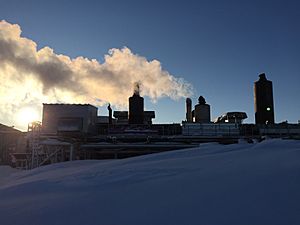
Nunavut's people rely primarily on diesel fuel to run generators and heat homes, with fossil fuel shipments from southern Canada by plane or boat because there are few to no roads or rail links to the region. There is a government effort to use more renewable energy sources, which is generally supported by the community.
This support comes from Nunavut feeling the effects of global warming. Former Nunavut Premier Eva Aariak said in 2011, "Climate change is very much upon us. It is affecting our hunters, the animals, the thinning of the ice is a big concern, as well as erosion from permafrost melting." The region is warming about twice as fast as the global average, according to the UN's Intergovernmental Panel on Climate Change.
Transportation
- Northern Transportation Company Limited, owned by Norterra, a holding company that was, until April 1, 2014, jointly owned by the Inuvialuit of the Northwest Territories and the Inuit of Nunavut.
Tourism
In the second half of 2018 travellers visited Nunavut 134,000 times and spent $436 million. Two-thirds of those visits were by Nunavummiut (residents of Nunavut) travelling within the territory. The remaining came from outside other provinces or territories in Canada, or from abroad and spent $219 million. Travellers from Ontario make up the largest portion of visitors from outside the territory. The majority of visitors from outside of Nunavut are business travellers; in the second half of 2018 only 14% of visitors were in the territory for leisure. Tourism recreation in Nunavut include activities like dog sledding, snowmobiling, cultural festivals, hiking, arctic wildlife safaris and sea kayaking.
Culture
Media
The Inuit Broadcasting Corporation is based in Nunavut. The Canadian Broadcasting Corporation (CBC) serves Nunavut through a radio and television production centre in Iqaluit, and a bureau in Rankin Inlet. Iqaluit is served by private commercial radio stations CKIQ-FM and CKGC-FM, both owned by Northern Lights Entertainment Inc. (CKIQ-FM had a rebroadcaster in Rankin Inlet that was discontinued in 2009.)
Periodicals
Nunavut is served by two regional weekly newspapers, Nunatsiaq News published by Nortext, and Nunavut News/North, published by Northern News Services, who also publish the multi-territory regional Kivalliq News.
Film
The film production company Isuma is based in Igloolik. Co-founded by Zacharias Kunuk and Norman Cohn in 1990, the company produced the 1999 feature Atanarjuat: The Fast Runner, winner of the Caméra d'Or for Best First Feature Film at the 2001 Cannes Film Festival. It was the first feature film written, directed, and acted entirely in Inuktitut.
The National Film Board (NFB) has released Animation from Cape Dorset (1973), a "collection assembles the first animated films to be made by Inuit artists at the NFB. Featured is work by Solomonie Pootoogook, Timmun Alariaq, Mathew Joanasie, and Itee Pootoogook Pilaloosie—all participants in the Kinngait (formerly Cape Dorset) Film Animation Workshop on Baffin Island."
In November 2006, the National Film Board of Canada (NFB) and the Inuit Broadcasting Corporation announced the start of the Nunavut Animation Lab, offering animation training to Nunavut artists at workshops in Iqaluit, Cape Dorset and Pangnirtung. Films from the Nunavut Animation Lab include Alethea Arnaquq-Baril's 2010 digital animation short Lumaajuuq, winner of the Best Aboriginal Award at the Golden Sheaf Awards and named Best Canadian Short Drama at the imagineNATIVE Film + Media Arts Festival.
In November 2011, the Government of Nunavut and the NFB jointly announced the launch of a DVD and online collection entitled Unikkausivut (Inuktitut: Sharing Our Stories), which will make over 100 NFB films by and about Inuit available in Inuktitut, Inuinnaqtun and other Inuit languages, as well as English and French. The Government of Nunavut is distributing Unikkausivut to every school in the territory.
Music
The music of Nunavut includes Inuit throat singing and drum-led dancing, along with country music, bluegrass, fiddling, square dancing and the button accordion from Austria.
Performing arts
Artcirq is a collective of Inuit circus performers based in Igloolik. The group has performed around the world, including at the 2010 Olympic Winter Games in Vancouver, British Columbia.
Sport
Nunavut competes at the Arctic Winter Games. Iqaluit co-hosted the 2002 edition in partnership with Nuuk, Greenland.
Hockey Nunavut was founded in 1999 and competes in the Maritime-Hockey North Junior C Championship.
Notable people
Susan Aglukark is an Inuk singer and songwriter. She has released six albums and has won several Juno Awards. She blends the Inuktitut and English languages with contemporary pop music arrangements to tell the stories of her people, the Inuit of the Arctic.
On May 3, 2008, the Kronos Quartet premiered a collaborative piece with Inuit throat singer Tanya Tagaq, entitled Nunavut, based on an Inuit folk story. Tagaq is also known internationally for her collaborations with Icelandic pop star Björk, and her 2018 novel Split Tooth which was longlisted for the Scotiabank Giller Prize.
Jordin John Kudluk Tootoo (Inuktitut syllabics: ᔪᐊᑕᓐ ᑐᑐ; born February 2, 1983, in Churchill, Manitoba, Canada) played in the National Hockey League (NHL) for from 2003 to 2017. Although born in Manitoba, Tootoo grew up in Rankin Inlet, where he was taught to skate and play hockey by his father, Barney.
Hunter Tootoo, Member of Parliament for the Territory of Nunavut, was elected to the Liberal government in 2015. He served as the Minister of Fisheries, Oceans, and the Canadian Coast Guard until his resignation from the post on May 31, 2016.
See also
 In Spanish: Nunavut para niños
In Spanish: Nunavut para niños




